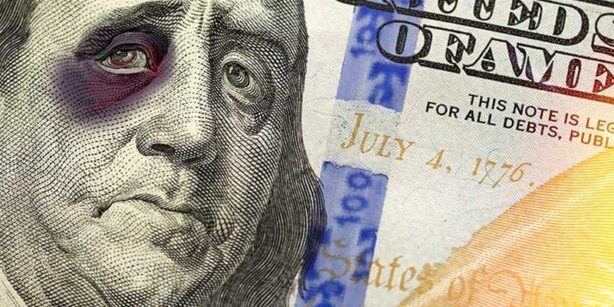
Doom Spending: The Fed’s Quiet War on the American Dream
“Doom Spending” Is Sad
Eat. Drink. And be merry — for tomorrow we die.
Poor economic omens litter the heavens. Among these are plunging manufacturing and wobbling unemployment.
Meantime, some 96% of Americans fear for the United States economy.
Yet consumer consumption — said to represent 70% of the gross domestic product — remains a-jump.
Why is the American consumer evidently so flush? Why is she spending money she herself lacks?
The answer, in every likelihood, is “doom spending.” Doom spending:
When a person mindlessly shops to self-soothe because they feel pessimistic about the economy and their future.
The Young Feel Doomed
The youthful evidently sense doom all about them. It is they who are most given to doom spending. Zero Hedge:
Over 27% of respondents (most of them Gen Z and millennials) to a recent survey conducted by Qualtrics and commissioned by Intuit Credit Karma admitted to “doom spending,” and 32% have taken on more debt in the last six months. U.S. consumer debt stats reveal the true nature of this disastrous trend.
United States credit card debt perches at record heights… at $1.14 trillion specifically.
Combined United States household debt likewise registers fresh records, at $17.3 trillion.
Debt Itself Isn’t the Problem
Debt — in itself — is not necessarily the scarlet sin of profligacy and wastreldom.
A man may heave himself into debt to expand his business in anticipation of fat times ahead.
His debt may thus be considered productive debt.
Yet doom spending is not productive. It is not merely unproductive, it is anti-productive.
It represents life upon the hamster wheel, of running fast but standing still. It lives for today.
It mistakes activity for action, performance for purpose, motion for direction.
It may keep the show running — temporarily at least. Yet it meanders down the garden path to economic immiseration and perdition.
It is the economics of the shiftless and the juvenile. It is the economics of the ostrich.
30% of American Consumers Have Tuned Out
Zero Hedge:
The U.S. economy is far from recovery. In fact, its continuous decline is being misrepresented as a “rebound” partly because of the bizarre habits of a contingent of American consumers.
Doom spending helps to explain a number of inconsistencies in current retail data and also presents a disturbing reality – that almost 30% of the U.S. consumer population has no plans to prepare for the future and is incapable of mentally adapting to sour financial conditions. In other words, they refuse to take responsibility for their own personal survival.
Thus doom spending is “unhealthy and fatalistic,” argues a certain Ylva Baeckstrom, finance lecturer at King’s Business School.
We must conclude she is correct. Yet is doom spending justified by the facts? Perhaps it is to a certain extent.
Young Americans Believe They’re Worse off Than Their Parents
For the first occasion in generations, youthful Americans believe they will fare less well than their parents.
They believe they are being served the uncooked meal — the raw deal.
Median earnings for those 25–34 have lagged older Americans since the Great Recession.
Compare them to the youths of 1987. Today’s youthful pay triple the rent of 1987’s youthful. Today’s house is five times costlier than 1987’s.
In 1989, the youthful cohort stored in 20% of all United States wealth.
Today the youthful cohort boasts under 10% of all United States wealth.
The abovesaid Ylva Baeckstrom:
The generation growing up now is the first generation that’s going to be poorer than its parents for a very long time. There’s that feeling that you might never be able to achieve what your parents achieved.
The True Villain
It is time to identify the central villain of our woeful intergenerational tale, in our telling at least.
That villain is the Federal Reserve Bank of the United States.
Following the vast tumults of 2008 the Federal Reserve nailed interest rates to the floorboards, commenced multiple rounds of quantitative easing and made itself a general economic menace.
This it did to engorge asset prices — of stocks and houses in particular.
People’s stock portfolios and house values went galloping. So enriched, they would spend money.
The resulting “wealth effects” would gush into the broad economy and lift all boats to a higher economic water level.
Here we cite arch-villain Ben Bernanke himself:
Higher equity prices will boost consumer wealth and help increase confidence, which can spur spending.
A Form of Generational Warfare
Who were the prime beneficiaries of this Federal Reserve welfare? Existing homeowners and those who could afford to throw money at stocks.
These were of course Americans of advanced vintage. The youthful were heavily excluded from the calculus.
It is fantastic for the seasoned American whose house that was worth $300,000 10 years back is now worth $800,000.
But what of the underripe American who wishes to purchase that home when it falls upon the market? He cannot do it. He is frozen out.
He may be able to collar the resources for the $300,000 purchase — but not the $800,000 purchase.
And so he repairs to his high-rent apartment and stews in his boiling juices, frustrated.
Is it any wonder that he abandons hope in his future and takes to juiceless doom spending?
It is no wonder whatsoever. The wealth effect has not affected him — not positively that is.
The Wealth Defect
Mr. Christopher P. Casey directs WindRock Wealth Management. From whom:
Across all financial media, between both political parties, and among most mainstream economists, the “wealth effect” is noted, promoted and touted. The refrain is constant and the message seemingly simple: By increasing people’s wealth through rising stock and housing prices, the populace will increase their consumer spending, which will spur economic growth.
Its acceptance is as widespread as its justification is important, for it provides the rationale for the Federal Reserve’s unprecedented monetary expansion since 2008… [However], the wealth effect is but a mantra without merit.
A mantra without merit? Please explain, sir.
The most important component of the wealth effect is the assumption that increased consumer spending stimulates economic growth. It is this Keynesian concept which is critical to the wealth effect’s validity. If increased consumer spending fails to stimulate the economy, the theory of the wealth effect fails. Wealth effect turns into wealth defect.
Wealth defect! We like it! Please continue.
There Is No “Paradox of Thrift”
[The Federal Reserve] believes in the paradox of thrift — the belief that increased savings, while beneficial for any particular economic actor, have deleterious effects for the economy as a whole.
The paradox of thrift can essentially be described as such: Decreased consumer spending lowers aggregate demand which reduces employment levels which negatively affects consumption which in turn lowers aggregate demand. The paradox predicts an economic death spiral from diminished demand.
You disagree?
History suggests the opposite: It is higher savings rates which lead to economic prosperity. Examine any economic success story such as modern China, 19th-century America or post-World War II Japan and South Korea: Did their economic rise derive from unbridled consumption, or strict frugality?
The answer is self-evident: It is the savings from the curtailment of consumption, combined with minimal government involvement in economic affairs, which generates economic growth.
Giving up on the American Dream
We have argued the identical case in these pages — and often.
Authentic wealth springs not from monetary manipulation and gimcrack but from toil and savings.
All efforts to elevate the first at the expense of the second will come inevitably to grief.
They end in such derangements as “doom spending” by the youthful.
The financial and fiscal authorities have dealt them a very poor hand of playing cards.
Alas, many are folding their bum hands… and walking away from the American dream…
This article originally appeared on the Daily Reckoning











